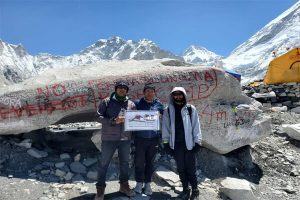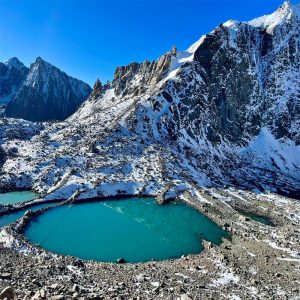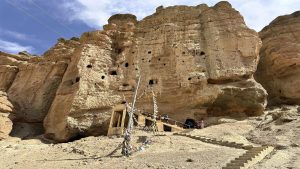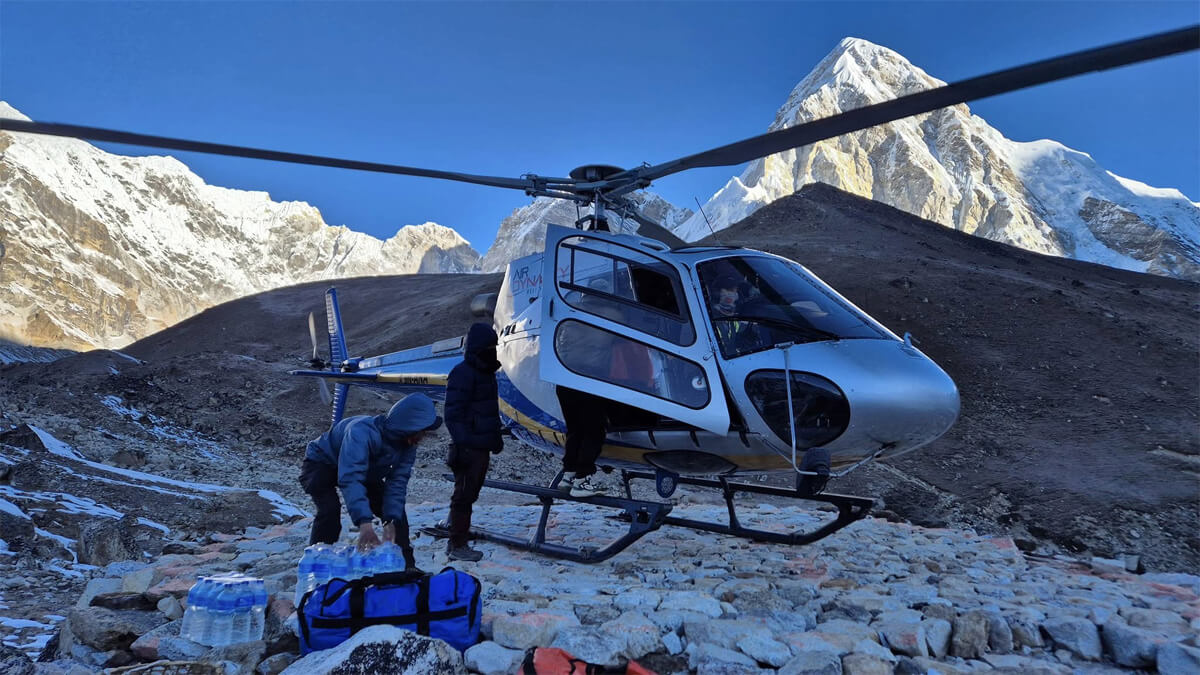Nepal is a small country with many huge mountains. People from all over the world come here to walk in the Himalayas. We call it trekking. One must trek on mountain routes to see nature, villages, and snow-capped summits. Mount Everest is the most well-known mountain in Nepal. The country is also home to several other stunning places, including Annapurna, Langtang, and Manaslu.
Trekking in Nepal is exciting, adventurous, and healthy. You do not have to be a mountain climber to enjoy walking and exploring. Treks range from easy for beginners to challenging for experienced trekkers.
People can learn more about these treks from our company,Nepal Trekking Routes. We provide maps, information, and safety advice. In order to make visitors feel secure and at home, we also support tea houses and local guides.
It is a good idea to know the cost of trekking before you go. The price of trekking in 2025/026 can vary according to your destination, the number of days you walk, and the services you select. You can plan your ideal trek in Nepal worry-free if you grasp all the charges with the help of our guide. Let us begin your mountain journey!

5 Popular Treks in Nepal and their cost
1.Everest Base Camp Trek
Trek Duration: 12-14 days
Average Cost: 1,200 – 2,000 USD
The Everest Base Camp is the most well-known trekking destination in Nepal. The world’s tallest peak, Mount Everest, is happy to be here. Seeing Everest up close is a dream for many people. This area offers stunning, thrilling, and adventurous treks. You walk through wonderful mountain villages, forests, rivers, and snowy paths to reach the base of Mount Everest. However, what is their price? Let us discuss the costs involved.
One of the most well-known treks in Nepal is to Everest Base Camp. People travel from all over the world to see the stunning mountains, explore the tiny communities, and see Mount Everest’s base. However, it is crucial to know how much money you might require before you leave.
Each person may incur a different price for the Everest Base Camp Trek. The number of days you wish to trek, whether you want to hire a guide or porter, the type of hotel you stay at, and your mode of transportation all have a role.
The price increases if you fly from Kathmandu to Lukla. The cost also increases if you stay in finer tea houses (little lodgings along the trail) and eat more. Trekking in a group can be less expensive for certain people, while going on a solo excursion can cost more.
To reach the Everest region, you will also require certain permits, which are very expensive. Although it is safe and beneficial, hiring a guide raises the price.
Typically, the price covers permits, dinner, lodging, the guide, and porter. However, it might not include insurance, internet, hot baths, tips, or food. Therefore, having some extra cash on hand is a good idea.
The Everest Base Camp Trek is worthwhile despite the expense. You will encounter amiable people, witness breathtaking vistas, and create lifelong memories. You will love your experience if you choose the proper trekking company and carefully consider your budget.
2. Annapurna Base Camp Trek
Duration: 7-11 days
Average Cost: $900 – $1,500 USD per person
You will reach the foot of one of the world’s highest mountains, Mount Annapurna, during the Annapurna Base Camp (ABC) Trek. This trek does not require you to be an expert in mountains. Families and beginners alike will love it!Pokhara is where most people start. You next take a quick drive to the trek’s beginning location, which is either Nayapul or Ghandruk. You will witness waterfalls, over little bridges, stroll through forests, and take in vistas of the mountains. You pass quaint little communities with welcoming residents along the route. Rice fields and vibrant rhododendron trees are also visible, particularly in the spring. You stay in tea houses. In addition to a bed, these little mountain lodges serve hot soup, momos (dumplings), and dal bhat (rice and lentils).Annapurna Base Camp has a breathtaking sunrise! At sunrise, the snow on the mountains turns golden.

3. Langtang Valley Trek
Trek Duration: 7-10 days
Average Cost: $900- $1,300 USD
The Langtang Valley Trek is one of the most stunning and reasonably priced trekking routes in Nepal. Spending a lot of money is not necessary to enjoy this incredible adventure. How long you want to walk, where you stay, how you travel, and whether you hire a guide or porter are some of the factors that affect the expense of this expedition.
From Kathmandu, you can travel to Syabrubesi, the start of the trek, by private jeep or local bus. The jeep is quicker and more pleasant, but the local bus is less expensive. It is very inexpensive to stay in tea houses along the way. In addition to basic lodging, these tiny lodges serve tea, rice, soup, and noodles.
Although hiring a guide will cost more, they will help you stay safe and provide you with information about the mountains and culture. To make walking easier, a porter can carry your bulky backpack. Entering Langtang National Park also requires a permit, which costs a little.
All things considered, the Langtang Valley Trek is less expensive than other well-known Nepali treks like Everest or Annapurna. In a single journey, you can see nature, local life, and mountain views. It is ideal for those looking for an inexpensive, quick, and serene trekking trip.
4. Manaslu Circuit Trek
Duration: 14-18 days
Average Cost: $1,200 – USD 1,900 per person
The Manaslu Circuit Trek is a stunning and serene trekking route in Nepal. It circles the eighth-highest mountain in the world, Mount Manaslu. Because it is less busy than the Everest or Annapurna regions, this journey is very popular. However, how much does this expedition cost?
A number of factors affect the cost of Manaslu Circuit Trek. First, the number of days you wish to trip will determine this. The average person takes 14–18 days. The fee will be higher for a longer travel. Secondly, the type of service you desire will determine this. The cost will increase if you want superior accommodations, private guides, and other amenities.
Permits are another significant expense. This trek requires special trekking permits because it passes through a restricted region. Additionally, you must always have a guide with you. This is not a trek you can accomplish alone. It costs a little more than other treks because of this.
During the walk, accommodations and food are basic. You will taste regional cuisine while lodging in modest lodgings. You still have to pay for all of your meals, although these items are less expensive than in the city.
Transportation raises the price as well. Most tourists take a jeep from Kathmandu to the starting location of the trek. This is not inexpensive and can take seven to nine hours. Additionally, some customers demand snacks, equipment rental, and travel insurance, which raises the price.
All things considered, the Manaslu Circuit trip is among the greatest if you are looking for quiet, mountain views, and local culture, but it is not the most affordable trip in Nepal. With careful preparation and a reliable guide, the trek is well worth the money. Numerous individuals claim that it is among the best treks they have ever undertaken.
Manaslu is a fantastic option if you want excitement and do not mind paying a little bit more than other treks!

5. Kanchenjunga Base Camp Trek
Duration: 15-20 days
Average Cost: $1,700 – USD 2,500 per person
One of the most secluded and breathtaking treks in Nepal is the Kanchenjunga Base Camp Trek. It leads you to the base of 8,586-meter-tall Mt. Kanchenjunga, the third-highest mountain in the world. The trek is typically more costly than well-known treks like Everest or Annapurna since it is lengthy, less populated, and deep in the Himalayas.
Transportation is one of the main causes of the increased price. Taplejung, where the journey begins, is a long way from Kathmandu. Typically, getting there entails flying to Bhadrapur, followed by a lengthy drive or another quick flight. These modes of transportation raise the overall cost.
In the Kanchenjunga region, there are not many lodges or teahouses, so you can occasionally have to tent, which raises the price. Since this location is a restricted trekking area, it is necessary to hire a licensed guide and porter. Additionally, you will require special permits, which are more expensive than those for standard trekking routes.
Food, water, and internet connectivity are all more expensive and difficult to obtain in this less commercialized section of Nepal. In order to handle permits, logistics, guides, and safety, the majority of trekkers sign up for an organized trip through a local organization.
Although the Kanchenjunga Base Camp Trek can be more expensive overall than other well-known routes, the experience is rich and fulfilling. You encounter indigenous Limbu and Rai villages, traverse high passes, stroll through rhododendron forests, and take in the sight of enormous, uncrowded mountains. For those seeking peaceful trails and authentic Himalayan experience, it is the ideal option.
In order to better budget for 2025 or 2026, it is a good idea to make reservations in advance and inquire about the inclusions of trekking firms’ packages.
Main Factors That Affect Trekking Costs in Nepal
Knowing the factors that affect the trek’s cost is helpful if you are considering trekking in Nepal. Trekking is spending many days on foot in the mountains. Treks can range in length from short to lengthy. There are easy and difficult ones. These factors all affect the price. Let us examine the primary factors that influence your spending.
1. Trekking Region
Nepal offers a wide variety of trekking destinations. Some are less expensive because they are near Kathmandu or Pokhara. Others, such as the Kanchenjunga region or Everest, are far away and need a lengthy drive or flight. They are therefore more expensive. For instance, the cost of the Everest Base Camp Trek is higher due to the need to travel to Lukla.
2. Length of the Trek
It will be less expensive if your expedition is only five to seven days long. There will be fewer dinners, guesthouse nights, and days spent with your porter or guide. However, the cost increases if your journey is longer, say 15 to 20 days, as you will be spending more money on food, sleeping accommodations, and spending more time with your trekking team.
3. Transportation
You might require a bus, vehicle, or airplane to get to the starting site for the walk. Buses take longer but are less expensive. Jeeps are faster but slightly more expensive. The most expensive are flights. For instance, a one-way ticket to the Everest region costs about $180. Certain treks, like Langtang, are less expensive because they do not require flights.
4. Guide and Porter
It is a fantastic idea to hire a guide. A guide tells you local tales, shows you the way, and keeps you safe. To make walking easier, a porter handles your bulky bag. Porters and guides are expensive. Your trek will be more affordable if you forgo them, but it will also be more difficult. For comfort and security, a lot of trekkers choose for a guide.
5. Accommodation and Food
You stay in tea houses, which are little mountain hotels, while trekking. Some are simple, and some are finer. Simple tea establishments are less expensive. You will pay more for a room with a hot shower or private toilet. Additionally, you will require three meals per day, which are often tea, bread, soup, and rice. Food costs more in higher elevations since it is more difficult to transport.
6. Permits and Fees
Certain treks require specialized permits. These documents permit you to access a trekking region. For Annapurna, for instance, you require a national park permit and a TIMS card. You also need a restricted area permit, which is more expensive, for Manaslu or Upper Mustang. Before you leave, always inquire about permission fees.
7. Trekking Style
There are three types of treks to choose from: normal, luxury, and budget. Simple accommodations, no hot showers, and packing your suitcase are all part of a low-budget expedition. You get a porter, a guide, and delicious cuisine on a typical trek. Better accommodations, better cuisine, and more comfort are all part of a luxury journey, but the price is much higher.
Consider the length, destination, mode of transportation, assistance, and level of comfort while organizing your trek in Nepal. Each of these factors affects the cost. You may have a fantastic trek that fits within your budget if you plan!
Conclusion
Trekking in Nepal in 2025/026 can combine affordability and enjoyment. Where you go, how long you stay, and the type of service you select all affect the price. Well-known treks that cater to a variety of budgets include Everest Base Camp, Annapurna Base Camp, and Langtang Valley. You have the option of more comfortable luxury treks with superior accommodations and cuisine, or more affordable treks with simple tea houses.
You can enjoy the trip stress-free if you plan your money. Do not forget to budget for food, permits, guides, and little extras like snacks or Wi-Fi. There is a trek in Nepal for everyone, regardless of whether you are traveling alone or with friends, or with family.
